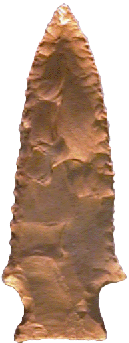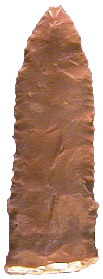



Point Type: HARPETH
RIVER
Also See: Baker's Creek, Dalton-Greenbrier, Dalton-Nuckolls, Mud Creek, Russell Cave, Searcy
Location: Southeastern United States
Associated Dates:
11,000 - 8500 B.P. - Transitional Paleo - Early Archaic
Morphology: Stemmed / Auriculate
General Description: The Harpeth River is a medium to large sized narrow, thick, serrated, stemmed dart point or knife blade that is steeply beveled on all four sides. The blade faces have shallow random percussion flaking across the blade surfaces and then fine edge retouching forms fine serrations. The blade edges are excurvate on pristine specimens and are straight on reworked points. The cross-section is flat. The distal end is usually acute. Very shallow side notches are removed making a slightly expanding stem and revealing shoulders. The shallow notches are often retouched resulting in expanded shoulder barbs. Highly reworked points have steep bifacially beveled edges. The type has shoulders on new specimens but then changes over to a lanceolate form on reworked specimens as the blade width is reduced and the shoulders have been removed after a number of resharpenings. In this stage of rework, the Harpeth River could appear to be a worn-out Greenbrier Dalton point.
The Harpeth River type has a late Paleo-Indian early Archaic affiliation having been found on sites with established Early Archaic point types. A cache of points was found in early 1993 which contained four Kirk Stemmed Points and one classic Harpeth River point. The point is found in Tennessee, western Kentucky, northern Alabama and northern Mississippi.
The size of Harpeth River point can range from 51 mm to 90 mm in length. The typical width is between 19 mm and 32 mm. The point was named by James W. Cambron for examples that were found by Wayne Crabtree along the Harpeth River, in Cheatham and Dickson Counties in Tennessee.
About the Point Above (Left): The large Harpeth River point pictured at the top left of this page, was found near the town of Ramar, Tennessee in a creek bottom. This specimen represents the near orginal form of the Harpeth River type. Notice that the barbs and shoulders have not been removed due to rework. The point is beveled in a steep manner on all four faces of the blade edge. The point is made from a glossy tan flint material with light cream colored inclusions and is stained to a coffee with cream color perhaps due to creek water patination. Overall, the point measures 89 mm in length, is 31 mm wide across the barbs and is 9 mm thick in mid blade. The base is ground as are the sides of the hafting area. Catalog Number 83-45-D
About the Point Above (Right): The highly reworked Harpeth River point pictured at the top right of this page, was also found near the town of Ramar, Tennessee. This specimen appears to be lanceolate in shape, however it is highly reworked due to resharpening and the stem is now the widest portion of the projectile. Notice that the barbs and shoulders have been removed due to rework. The point is made from a glossy tan flint material with light cream colored inclusions (note this appears to be made from the same material as the point above). Overall, the point measures 72 mm in length, is 23.5 mm wide at the top of the stem and is only 6.5 mm thick in mid blade which is thin for the type. The base is ground as are the sides of the hafting area. Catalog Number 82-45-D
References: Justice, Overstreet, Perino (2), Powell, Puckett (1)
© Copyright 1997 - 2008 LITHICS-Net WWW.LITHICSNET.COM
Use Your Browser's BACK Button to Return to the LITHICS-Net Index.